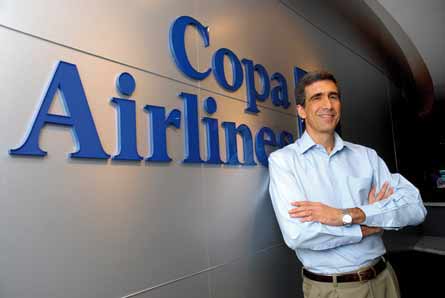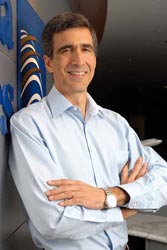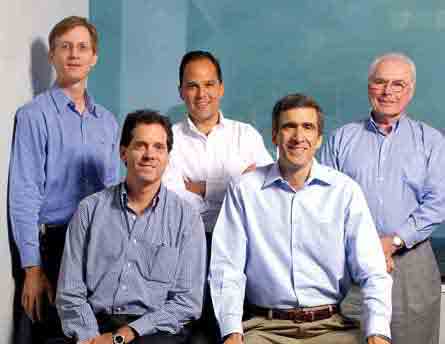Pedro Heilbron heads a board implementing a single-hub, multi-spoke strategy to good effect at the Panamanian carrier Copa
Ask Pedro Heilbron to talk about his airline, Copa, and he'll say no. That is, not unless the rest of his management team is with him. That shows how much Heilbron believes in the teamwork that has made the Panamanian carrier into one of the fastest growing and most respected in Latin America and a hot item on the New York Stock Exchange.
| |
|---|
The airline needed a strong team to get where it is, because it works from a base that may have a splendid new airport and a prosperous economy, but is not nearly large enough to serve as a strong home market for an airline that wants to grow. Panama is, after all, a small country, and even with its role as a centre of regional business and finance, its tourism attractions and its canal's importance in commerce, its 3 million people form too small a population for an airline with over 60 aircraft by 2009 to rely on.
So Copa's mission has been to give people a reason to fly there. Heilbron and his team have crafted a compelling argument for travellers to fly through Panama as well as
| Copa at a glance Revenue $609 million Change 52.2% Operating margin 17.9% Net margin 13.6% Year end December 2005 Airline Business traffic ranking 126 RPK growth 27.0% ASK growth 21.1% Load factor 73.4% |
|---|
And so teamwork is needed from the top levels at Copa's ultra-modern steel and glass headquarters near Panama City's eastern edge, right down to the baggage holds beneath the city's still-under construction Tocumen airport. The strategic decision was to make Copa a single-hub, multi-spoke airline and the marketing decision that followed was to sell it to travellers as an easier connection than any rival interchange. The entire airline has to work together and with clockwork precision at least twice a day. And as the airline adds more destinations and a second fleet type, that challenge becomes even more demanding.
Heilbron's team represents similar backgrounds but vastly different personalities: like Heilbron, all have an international education. The airline's chief financial officer, Victor Vial, went to the George Washington University in Washington DC, as did Heilbron, and was planning director from 1995 to 2000, while Jorge Garcia, the vice-president commercial since 1999, earned an MBA at Boston University.
These two men, despite their similar ages and background, have very different personalities. Vial, like many financial gurus, is reserved and inclined to speak in facts rather than opinions, while Garcia is a more spontaneous personality. Both speak intimately of the company and sometimes one finishes the other's sentences. A fourth team member is former American Airlines finance and alliance executive Dan Gunn from the USA, a reserved and quiet man who, like the two others, is quick to smile.
Chief operating officer Larry Ganse is a veteran of TWA, Northwest and TACA flight operations. They are clearly easy and relaxed in the presence of their boss, and Garcia explains the management style: "Oh no, we never tell Pedro he's wrong," he laughs. "We manage by sticking our heads into each other's offices." Heilbron sits, almost like a solemn father figure, until a smile spreads over his face. His habit is to speak slowly, in a calming manner, as if to signal that his is a thought based on reflection, or that his decision is the result of a balancing process.
Heilbron prefers a fairly structured management style, with frequent meetings, although he directs meetings downwards as well as horizontally: "I make it a point to meet every new employee and to talk to new employees in a group, and have employee meetings monthly, here in the headquarters or on site." Meeting with employees may not seem radical, but in the usually top-down Latin corporate structure, it is a change. Copa's 3,100 employees seem to like his approach: staff turnover is low and last month Copa was named one of the 10 best employers in Latin America by the magazine America-Economia. This is the second time since 2004 that Copa has won the award, which is based on a survey by the human resources consultancy Hewitt Associates.
The teamwork that Heilbron stresses also brings with it a challenge. In any management structure that tries to share "the vision thing", those shared insights and perception, there is a risk that the enterprise can lose focus. In a tightly drawn niche like Copa, this would be a danger, but in fact it seems to make the team focus on each other more. As Jorge Garcia puts it: "We get up every morning and ask ourselves how we can be a better company, which is good because it keeps us from getting distracted."
Join the dots
| Latin leader
Pedro Heilbron has a motto he learned from his hero, Alberto Motta: "Never fall in love with airplanes." That has served him well in leading Copa into the first ranks of Latin airlines, but Heilbron, 48, credits Motta, "a very special person", with more than a slogan. Motta, who died in September at the age of 90, was a member of one of Panama's leading business families who brought Heilbron into the business, first at their Motta Trade Group and then into the airline in 1992. The family was the major investor in Copa before the Continental Airlines relationship and Copa's rapid expansion. Heilbron negotiated Copa's independence from Motta family control in 1998, and from TACA, the Central American airline group. Since then, Heilbron has been cited by many as a leader, recognised for his role in transforming regional association AITAL into ALTA, where he has been vice-president and president. He has a degree from The College of the Holy Cross in Massachusetts and an MBA from the George Washington University. He is married with three children. |
|---|
What makes Copa fascinating is that for a carrier so very closely aligned to a North American partner, Continental Airlines, and that has North American airline service levels, Copa has a limited interest in the USA or Canada. "It's just not that big a part of our plans. We have the Continental codeshare for US access and in any case our niche is within Latin America," says Heilbron, who was educated in New England and knows the USA and its markets well. Copa's US destinations are Miami and Orlando, traditional Latin gateways and home to large Panamanian expatriate communities and Los Angeles, and New York City, both major business destinations for Latin executives.
But his future focus is on business travel city pairs such as the routes it was opening this year: Panama City to Manaus, Brazil, or Maracaibo, Venezuela, or in a very long segment to Montevideo, Uruguay, about 5,600km. Heilbron thinks not in terms of routes but in terms of the network. "The question is not so much should we go to Lima or how many business people in Lima come to Panama, but where would business travellers in Lima want to go that we can and do go to?" That leads to the development of traffic, as he puts it, "by onesies and twosies". Added traffic, drawn by the ecotourism of Panama's vast natural parks or the night-life of its booming casinos and clubs, is "gravy", he says.
Buck Horne, the Raymond James and Associates airline analyst who specialises in Latin carriers, quips that Copa has three basic factors going for it - "location, location, location". Copa's location is central, and Heilbron and his team know as much. Tocumen is located directly south of Miami and sits almost perfectly between the USA and South America. As importantly, it is at sea level and situated in an ideal weather region (save for brief but intense downpours), and so can operate without the weather restrictions that hamper other Latin American airports that are often in or next to mountainous terrain.
Tocumen is also one of the few airports in the region with two runways, and has room to add a third. Horne notes that it has driven passenger growth at a faster rate than Miami, despite the latter's larger size and traditional strength. Miami's growth is at best 7% or 8% annualised, while Tocumen, though handling only 2.76 million passengers a year, has been growing at 12-15% annually, Horne says. The relationship between Copa and Tocumen is also vastly different from the long-stormy relationship between Miami and just about any of its carriers. At Tocumen, Copa has a seat on the board of the semi-autonomous airport corporation and Heilbron feels the co-operation between the two is "really excellent".
Continental partnership
But Heilbron insists the location is not the reason Copa makes money: it is the "product". Here Copa has learned well and from a good teacher - Continental Airlines. Continental invested $53 million in Copa in 1998 and has reaped the rewards in two Copa flotations. These reduced the Houston-based carrier's stake from 49% to 27% in late 2005 and then in July to 10% raising $328 million in the process. But Continental is not going cold on Panama. Heilbron stresses that Copa and Continental are long-term partners, and notes that their codesharing, marketing and cross-pollination agreement was extended to run through 2015.
Copa is sometimes seen as a Continental clone, with branding that reflects that of Continental, but Heilbron insists that "we are a blend, taking the best they have to offer in operations and planning and blending it with our own brand of in-flight service". Copa is still controlled by a private shareholder, CIASA, which holds all capital-stock voting power and about 30% of a stake in the parent, Copa Holdings.
Doug Abbey, the Velocity Group consultant who has done project work for Copa, says: "Continental has been the way they laid their cornerstone of management, but the combination of the team's US education and local backgrounds lets them make a product that is tailored to the local market."
He says that while geography is on Copa's side, it faces the eventual prospect of losing a great advantage: the weaknesses of others. "No one else in the region has the right-size hub or the right size plane to do hub bypass and secondary-market development, but Copa knows it can't sit still," Abbey says. The LAN clones of Peru and Argentina are growing and TACA, to whose regional, multinational group Copa once belonged, is another strong challenger, although Heilbron insists its focus on growing its niche will enable Copa to withstand challenges.
Whatever form the emerging competitive threats take, the airline is doing well by any measure. Copa's operating margin was 17.9% in 2005, according to the Airline Business financial rankings, while LAN's was 5.7% and Gol's was 23.3%. Copa's third quarter net profit this year grew strongly to $37.2 million.
Horne of Raymond James estimates that Copa's stage length-adjusted unit revenues last year were just over 10.5¢, which compares favourably with network carrier unit revenues such as Delta's 9.9¢ or TAM's 9.6¢ and behind Continental's own outstanding 13.9¢. "While Copa may not necessarily qualify as a low-cost carrier, it certainly ranks as a high-margin airline," Horne says.
Heilbron's future focus will be on developing the basic model and then integrating AeroRepublica, the Colombian airline that Copa bought earlier this year. Heilbron says AeroRepublica was an opportunity buy rather than a strategic plan and does not see similar purchases of a similar scale in the near future. "It's in part opportunistic we were not just looking to go out and buy something. For us, it was an opportunity based on a very unique fit" given the long intimate relationship between Panama and Colombia, of which it was part until 1903.
As the airline grows, it stands to become a major force in aviation in the "northern cone" of the continent, and after a Panamanian vote in November easily approved a referendum to spend some $5 billion on new locks and dams for the Panama Canal, the nation's status as a global logistics hub, and a magnet for tourism and commerce is largely assured. And with that, as Merrill Lynch analyst Mike Linenberg notes, Copa's prosperity is about as certain as anything in the airline world can be.
| |
|---|
From left to right: Dan Gunn, Jorge Garcia, Victor Vial, Pedro Heilbron and Larry Ganse |
Source: Airline Business



















